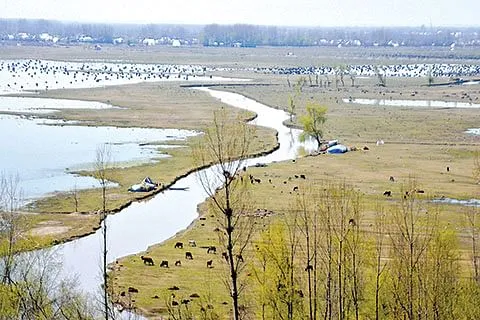Some 54 kilometers in the northwest of Srinagar is situated the largest lakes of Asia – the Wular lake, spanning Bandipora district headquarters and the Sopore town at an altitude of 1530 meters above mean seal level. Some believe that the present lake site was once a city of great, but wicked culture called Salamatnagar that submerged into water due to an earthquake. It is stated that before the devastating earthquake the area suffered moral waywardness. Its people were prosperous sharing some similarities with Mohanjadaro culture thereby establishing 5000 year old history of Kashmir. According to the Tareekhi Budshahi, Sultan Zain-ul-Abdideen, known to be virtuous ruler of Kashmir, between 1420-1470 AD, had built to the east of the lake, an artificial island called Zaina Lank, and a mosque where he would worship. Others had it as a refuge in times of ferocious winds that blew over the lake. Both narratives denote a positive spirit.
Nestled between the high mountainous ranges on the northeastern and the northwestern sides it acts as a huge absorption basin for flood waters, especially as a delta of river Jhelum, and maintains a balance in the hydrographic system in Kashmir. The lake with its associated wetlands/marshes works as a habitat for migratory water birds within Central Asian Flyway throughout the year, supporting rich biodiversity. It has an accident prone history as storms usually blow up in the afternoon and make it dangerous for navigation. Still it is a major resource for fishing, water chestnut, lotus, wickerwork material and terrestrial & migratory bird hunting, thus providing economic support to hundreds of households in the vicinity, besides generating incomes from the visiting tourists.
It has a great scope for water sports – boating, and water skiing. With hillock on its northern shore, Watlab, a middle point of 23 kilometer en-route journey between Sopore town and Bandipora, it hosts the shrine of Hazrat Baba Shakurddin – the spiritual guru of Hazrat Baba Piaam-ud-Din Reshi, whose shrine rests in the thick forests of Tangmarg to the side of famous health resort of Gulmarg at an altitude of about 9000 feet from the sea level, in the district of Baramulla. The shrine at Watlab over-viewing the four directions remains a point of attraction for religious pilgrimage/tourists, a year round means of livelihood to thousands of people camping around the sacred site.
In recognition of its immense ecological, socio-economic importance the lake was included in 1986 as a wetland of national importance under the Wetlands Programme of the Ministry of Environment & Forests. It was designated as a Wetland of International importance under the Ramsar Convention in 1990. The lake is one of the 26 Wetlands designated as a Ramsar site.
Ramsar is a global treaty that provides the framework for international cooperation for the conservation of Wetland Habitats and recognized as Ramsar Site. A study of the lake by the Wetlands International found that area of the lake was originally 217.8 square kilometers including 58 square kilometers of associated marshes. The total lake area got reduced from 157.74 square kilometers in 1911 to 86.71 square kilometers in 2007, thus making an aggregate reduction in area by 55 percent. If the shrinking of the lake continues at the same speed we will have no lake by the year 2065.
The threat to the lake comes from the conversion of parts of lake to agriculture and willow tree plantation patches. The indifference of the government and the activities of the unscrupulous would lead to the slow but sure death of the lake, unless some preventive and curative measures are taken up expeditiously.
The horizontal and vertical holding capacity of the lake has also reduced due to continuous massive siltation, draining off from the point and non-point sources of pollutants from the adjacent catchment areas, and also from the river Jhelum emptying itself in the lake, which in absence of any systematic dredging till date has increased the flood threat up & down stream in numerous low lying villages in the districts of Baramulla and Bandipore. Wular lake has generally remained unattended in terms of unabated encroachments. It is learnt that 21 lakh trees, mostly willow, have cropped up inside the lake. Felling of these trees has become a sine qua non to redeem the lake.
The lake which some 40 years back could be seen from the far off vintage point at Tshor Thuang- the foothill of the Sadder-Koot Payeen, can now be thinly visible at the nearest point at Gurura park as it is besieged by encroachments. The Governments have never before planned to rescue the lake till the recently established Wular Conservation & Management Authority created vide Government Order No.396–FST dated 10-10-2012 in pursuance of Cabinet Decision No.156/23/2012 dated 30-8-2012. It, inter alia, authorized the Authority to administer the affairs of the lake and its associated marshes, protect the lake ecosystem and catchment effecting the lake physique and aqua culture. But no dredging work has so far been or done fruitfully. Although it was heard that some Indo-Sino Company- a joint venture between Kolkata–based Reach Dredging Limited and a China-based Hubei Hongyan Engineering Company Limited had got the contract to complete the project within two years, yet we see no it implementation on ground. However, felling of 21 lakh trees, which are expected to fetch about Rs.200 crore, and some funding by the state and the central governments can ease the liquidity position for the achievements of physical targets of lake clearance, dredging, water management, aquatic security and prevention and cure of pollution – human, bovine and natural.
The importance of the lake is supreme as the lake is a being confluence of almost all the water bodies of Kashmir flowing downstream through Jhelum into it. The work has to be taken on fast track basis before this great water reservoir would be a thing past.
The author is a former Sr. Audit Officer and Consultant in the A.G’s Office Srinagar.






